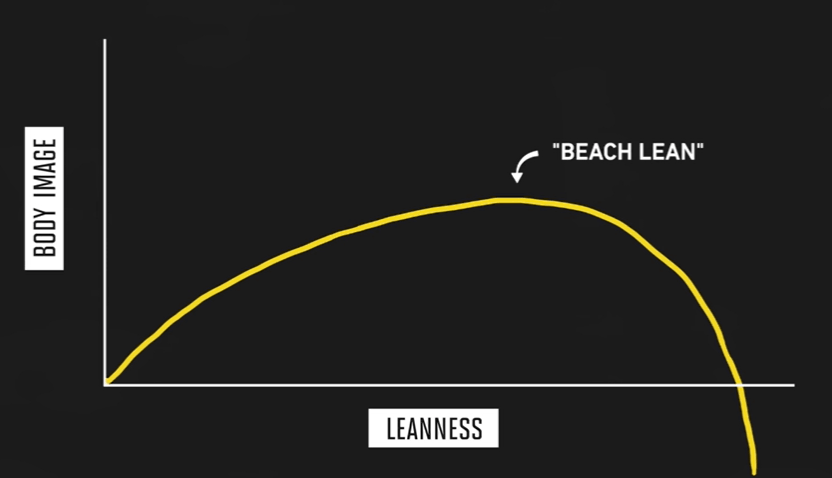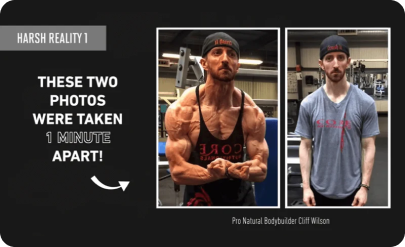As summer approaches, many lifters become preoccupied with getting shredded. Dare I say that some become obsessed with it? Most of us can appreciate a ripped physique, but the lifestyle is often anything but glamorous.
As we dig into this topic, I’ve included some photos of me posing at the leanest I’ve ever been. They were taken just a few weeks out from the California Natural Muscle Mayhem, where I won the Lightweight Class, the Overall, and earned my Pro Card in Natural Bodybuilding.

Keep in mind that these photos were shot on an iPhone 5S, so it doesn’t capture the best details. Below, are two progress photos from the same time frame, at the same level of leanness.

Although I speak to the grueling and ugly side of all this, I do think that this level of leanness looks pretty cool. I also understand and relate to why so many people aim for not just getting lean, but getting shredded and then staying shredded.
Inspired by seeing fitness influencers who maintain their shredded physique year-round, a lot of people set the same goal for themselves, without realizing the dark side of it all.
In this blog, I’m going to lay out 3 Harsh Realities of Being Shredded. I’ll then proceed to explain a better, more practical approach to getting and maintaining the physique you want.
HARSH REALITY #1
When you get shredded, if you have good lighting and a good camera, you’ll look your biggest and leanest when flexing or lifting. However, you’ll most likely look your smallest and most depleted for the other 23 hours of the day.

In this posing photo, Cliff is only 150 pounds (68 kilos) at 5 foot 5 inches tall. While he admits to looking more jacked here than usual, he’s quick to point out that he looked much less jacked than usual just walking around.

This is where the so-called Natty Triangle illustrates it well. As a natural lifter, most people get to pick 2. If you choose to be shredded and natural, don’t expect to be big. If you choose to be big and natural, you won’t be shredded. Thirdly, if you aim to be both big and shredded, you likely won’t be natural.

Obviously, there will always be a handful of freaks with one-in-a-million genetics who can be all three at once, but for the rest of us, we get to pick two.
HARSH REALITY #2
You may look like you’re in your best shape ever, but still not be any happier with the way you look. That’s because Body Dysmorphia is exacerbated at very low body fats.
For almost everyone I’ve ever coached, confidence and body image improves as they get leaner, but only up to a point. Most often, once they get past the so-called Beach Lean stage and start pushing into shredded territory, a switch flips in their brain and they can no longer see their physique objectively.

At that pivotal point, it’s very common to start noticing every little bit of fat on their body and get very critical about how they look. It’s only after the diet is over and they look back on their old progress photos that they think, “Wow, I didn't realize that I was actually that lean.” This is sad because people work so hard to attain a certain look that they don’t even appreciate once they get there.
HARSH REALITY #3
Being shredded comes with unhealthy side effects, even as a natural.
In the 2013 case study referenced below, researchers followed a natural male bodybuilder through 26 weeks (about 6 months) of dieting. In that time frame, he lost 30 pounds total and went from 14.8 percent body fat all the way down to 4.5 percent body fat ( measured by DEXA).

Note how he looked on stage at the end of the diet. You can see visible glute striations, no low back fat, feathered delts, and so on.

While he placed well at the show, his hormones took a huge hit, his testosterone levels dropped to a quarter of what they were at baseline. He went from a high 922 ng per dL - about as high as you tend to see in a natural lifter - all the way down to a clinically low level of 227 ng per dL. This would count as low even for someone in their 80s or 90s.
We can also see in the chart that his Ghrelin went up and his Leptin went down, meaning he must have felt super hungry all the time.

Note how his Cortisol levels skyrocketed, doubling throughout the diet. This was reflected in his total mood disturbance which increased by 617 percent throughout the diet.

Severe sleep interruption is another extremely common side effect which can be very frustrating. Essentially, your body is doing everything in its power to tell you to not sleep because you need to eat first.
In my experience, this is one of the most brutal aspects of getting shredded.
Case studies on women show similar negative health effects, plus the addition of menstrual cycle disruptions and consequences such as infertility and bone mineral loss.
This case study on a natural-figure competitor found that even 1.5 years after the competition was over, she still hadn’t regained her period.

Of course, not everyone is the same here. There are individual variances across the population. For example, one study found that 72 percent of competitors from both bikini and figure divisions combined had their period back after three to four months. Some of this variability could be due to the difference in leanness required for bikini versus figure, and whether or not the competitors were comfortable regaining healthy body weight.
Sometimes, the side effects can get bizarre. As an example, it’s common for competitors to get complaints that they smell like ammonia or nail polish. The caloric balance is so negative that the body turns to protein for energy, which is then converted to ammonia, and then excreted through sweat and urine.
It’s more common for competitors to do absolutely wild stuff with food. People will watch the food network non-stop, watch all kinds of food challenges, hoard cupboards full of junk food, and find things appetizing that really shouldn’t taste or smell good.
Here’s an example from an actual competitor.
“Let me illustrate how crazy it gets. The smell of dog food makes me f*** hungry and worse than that, the smell of his crap makes me hungry when I clean it up.”
You may be wondering if every shredded influencer has some sort of weird desire or craving like wanting to eat dog poop? Maybe. It could be that they’re secretly suffering just as much as the rest of us, but looking lean for their social media or for their business is simply worth the sacrifice for them.
It could also be that they’re on performance-enhancing drugs which can make maintaining a lower body fat a little bit easier. However, even with pharmaceutical enhancement, most people will still suffer similar side effects as naturals, except for the testosterone stuff.
Another perfectly possible scenario is that they simply have lower body fat set points than the typical person.
For example, I’d guess someone like David Laid is able to maintain six to eight percent body fat without suffering too much. I really doubt David Laid wants to eat dog poop. Based on his photos as a teenager, it seems like he’s just able to get lean and stay lean without trying that hard. But this isn’t common. Most people have a higher body fat set point than David Laid.
Let’s back up a bit so the point is clear.
Body fat set point theory is the idea that we each have a specific level of body fat that our body will fight to maintain. If we get too far below the set point, it pulls us back up by making us feel hungry and lethargic. If we get too far above the set point, it pulls us back down by turning hunger down and ramping up metabolism.
While set point theory originated in the 1950s and while it’s still a good model for a simple understanding, recent models have updated it based on new science. One of the prevailing theories these days is called the Dual Intervention Point Model. It says that instead of a single body fat set point, there are actually two points that each act as a boundary for a set range where our body is most comfortable. Hence the dual intervention point model.

According to this model, if I try to get leaner than eight or nine percent body fat, my body will absolutely punish me by skyrocketing my hunger, tanking my metabolism, and giving me all the bad side effects we just discussed.
Similarly, if I try to bulk beyond, say 25 percent body fat, my body will also fight me by lowering my appetite, boosting my metabolism, sweating like crazy, and so on.
But, I can get to the lower end of that boundary without too much resistance … and that’s the key: finding the lower boundary of your body fat set range. Although this range is different for everyone, that’s what can be sustainable.
See the chart below that illustrates how David Laid’s range might look compared to someone who’s more prone to obesity..

David Laid could get to six percent body fat and still feel fine, whereas the others might start to feel like death anytime they dip below 12 percent body fat.
Trying to stay shredded can also impair your ability to make progress in size and strength. People who stay shredded year-round have a hard time making any progress. In addition, the longer you stay below your set range, the more likely you’ll be to binge, see a weight rebound, and then end up sustaining a less lean physique than if you’d just been a bit more conservative with your low end, to begin with.
For the record, I’m cutting myself at the moment and that’s basically my goal: hit the low-end boundary of my dual intervention range and try to maintain there for a bit. Of course, it’s normal to feel hunger, experience some cravings, and even to see strength loss at a certain point.
Those things are expected to happen, even if you’re within your set range. It’s also normal for fat loss to be challenging, but once it goes from challenging to all-consuming, you’ll know. I’d say that’s when it’s time to probably re-evaluate your goals and clearly grasp why you set them in the first place.
If you’d like to review the points made in this blog, a video on this very topic is available on my YouTube channel.
That’s it for this one, guys. Thank you so much! I’ll see you guys all here for the next blog.
References:
Side Effects of Staying Too Lean:
https://pubmed.ncbi.nlm.nih.gov/23412685/
https://www.ncbi.nlm.nih.gov/pmc/articles/PMC5133123/
https://www.ncbi.nlm.nih.gov/pmc/articles/PMC5222856/
Body Fat Set Point:
https://royalsocietypublishing.org/doi/10.1098/rspb.1953.0009
Dual Intervention Model:
https://www.massmember.com/products/mass-subscription/categories/2150809186/posts/2159651372
"Can You Stay Shredded?" (MASS Article):
https://www.massmember.com/products/mass-subscription/categories/2150592792/posts/2158831500
https://www.youtube.com/watch?v=XfO8zz8N9l4&t=0s



